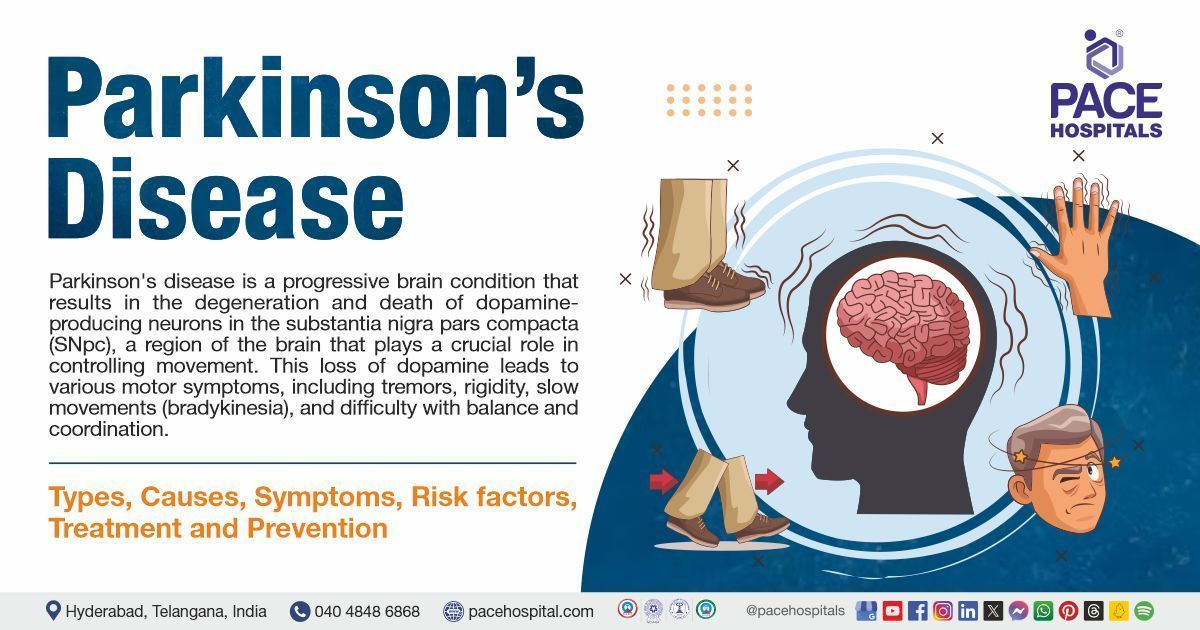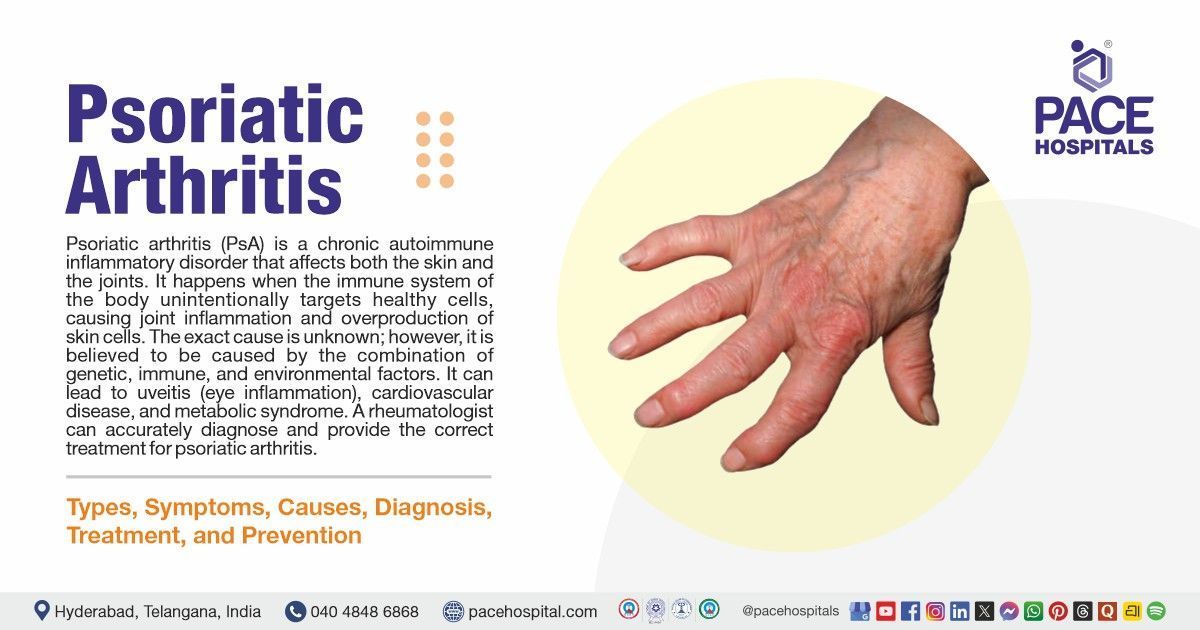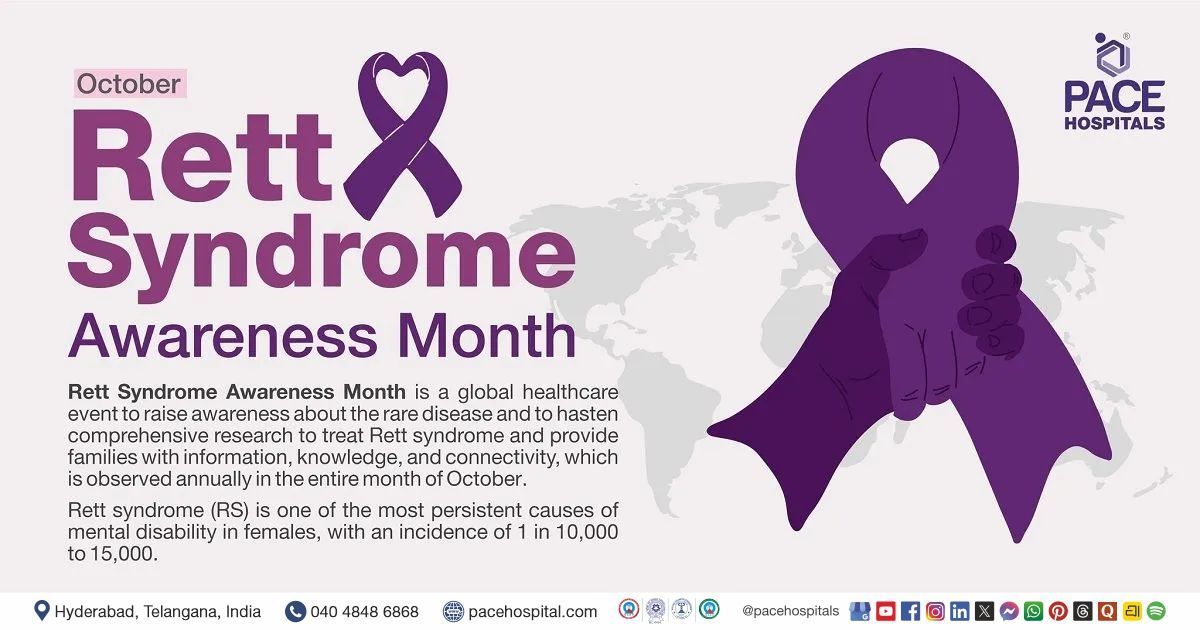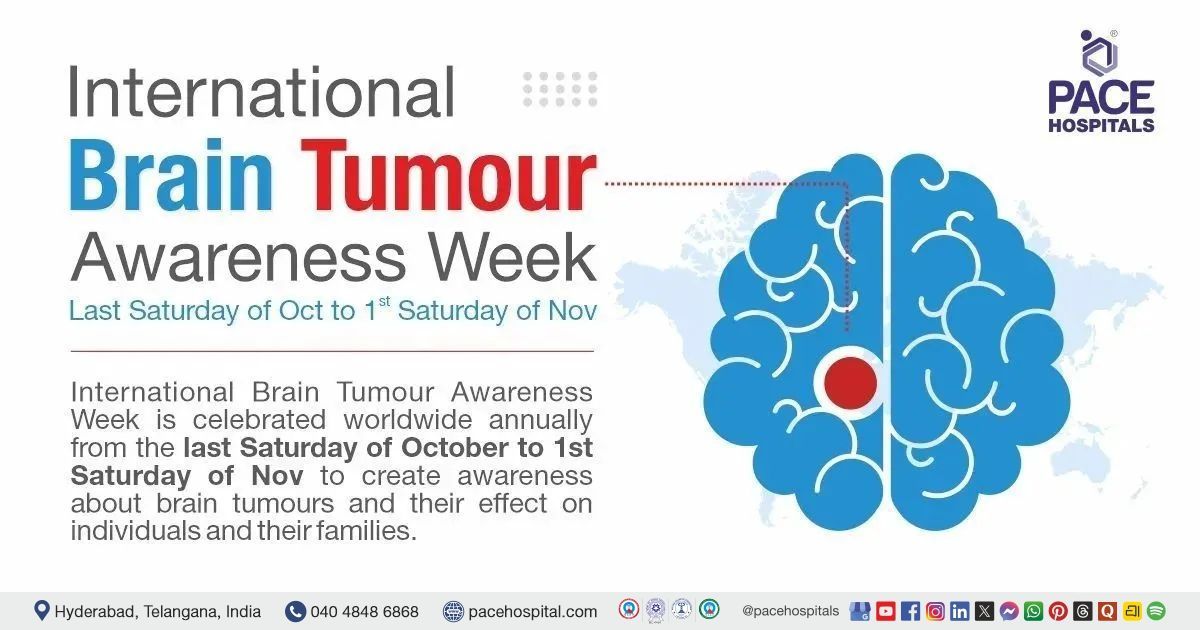Parkinson’s Disease - Types, Causes, Symptoms, Risk Factors, Treatment and Prevention
Parkinson’s Disease definition
Parkinson's disease is a slowly progressing brain condition that results in the weakening, degeneration and death of dopaminergic neurons (a type of neuron in the central nervous system that produces dopamine) in the substantia nigra pars compacta (SNpc) which is a part of the brain that controls movement resulting issues with motor skills, such as shaking, rigidity in the arms or legs, or difficulty maintaining balance.
As symptoms progress, individuals may experience difficulties walking, speaking, or carrying out basic activities. It's important to note that these symptoms may also occur in other medical conditions, so not everyone displaying these symptoms necessarily has Parkinson's disease (PD).
The impact of this condition varies from person to person, and progression rates differ as well. Typically, symptoms start on one side of the body and then spread to both sides, often affecting one side more than the other.
People with PD often develop a distinct walking pattern called "Parkinsonian gait." This gait involves a forward-leaning posture, rapid and short steps (festination), and reduced arm swinging on one or both sides. They may also have trouble starting to walk (start hesitation) and sudden stops while walking (freezing).
Parkinson’s Disease meaning
The term "paralysis" was coined in honour of the English physician James Parkinson (1755-1824)., who first described the condition in 1817 using the terms "shaking palsy" and "paralysis agitans." This naming originated from the French "maladie de Parkinson" in 1876.
Prevalence Of Parkinson's Disease
- The prevalence of Parkinson's disease (PD) is around 1-2 per 1000 people at any time.
- The possibility of having PD increases with age, affecting around 1% of people over 60.
- Additionally, 5% to 10% of patients have a genetic predisposition to acquiring this disease.
- PD is more common in men than women, and its incidence and prevalence increases with age.
- Disability and death due to PD are rising faster than for any other neurological disorder.
- The prevalence of Parkinson's disease (PD) has doubled globally in the past 25 years, with over 8.5 million individuals living with PD in 2019.

Types Of Parkinson's Disease
The below mentioned are different types of Parkinson’s disease, including:
- Primary Parkinson’s Disease
- Idiopathic Parkinson’s Disease
- Early-Onset Parkinson’s Disease
- Juvenile Parkinson’s Disease
- Later-onset Parkinson’s disease
- Secondary Parkinsonism
- Atypical Parkinsonism (Parkinson-Plus Syndromes)
Primary Parkinson’s Disease
This includes conditions where parkinsonian symptoms arise without an identifiable secondary cause. This Parkinson’s disease subtypes include:
- Idiopathic Parkinson’s Disease: Idiopathic Parkinson's disease is characterized by the presence of parkinsonian symptoms (bradykinesia, tremor, rigidity) with no clear underlying or identifiable cause. It is the most prevalent form of Parkinson’s disease and is sometimes referred to simply as "Parkinson’s disease."
- Early-Onset Parkinson's Disease: This term is used when Parkinson's disease begins between the ages of 21 and 40.
- Juvenile Parkinson’s Disease: Juvenile parkinsonism, a condition that is uncommon, starts during childhood or adolescence and can last up to 20 years.
- Later-onset Parkinson’s disease: It starts later in life as they progress at a slower rate. They are highly responsive to dopaminergic treatments. Most of the impairment arises from nonmotor symptoms including depression, anxiety, and pain.
Secondary Parkinsonism
Secondary parkinsonism is a neurological condition characterized by the blockage of dopamine in the basal ganglia, like Parkinson's disease, but caused by factors other than Parkinson's disease, such as:
- Medications (Medication-Induced Parkinsonism)
- Trauma (Post-Traumatic Parkinsonism)
- Cerebrovascular disease
- Postencephalitic changes (Neurological alterations resulting from inflammation of the brain are caused by encephalitis)
Atypical Parkinsonism (Parkinson-Plus Syndromes)
Atypical parkinsonism is a group of degenerative disorders that share some similarities with Parkinson's disease but have distinct clinical features, a poor prognosis, a limited or no response to levodopa, and different underlying pathology. These disorders include:
- Multiple system atrophy (Progressive neurodegenerative disorder that presents with a variety of symptoms affecting movement, balance, and autonomic functions.)
- Progressive supranuclear palsy (a rare, progressive neurodegenerative disorder characterized by problems with movement, balance, and eye control due to damage in specific brain areas.)
- Dementia with Lewy bodies
- Corticobasal ganglionic degeneration (It is a rare, progressive disorder causing motor and cognitive symptoms due to degeneration of brain regions involved in movement and coordination).
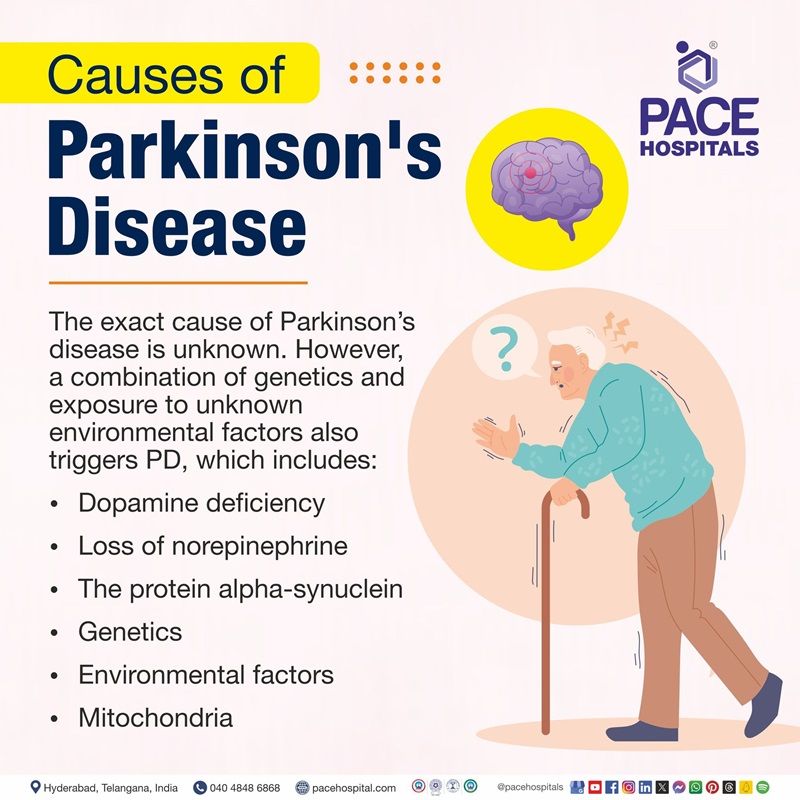
Parkinson’s Disease Causes
The etiology of Parkinson’s disease is unknown. However, most cases are sporadic (the disease does not typically run in families). Some cases are hereditary and can be caused by genetic mutations. A combination of genetics and exposure to unknown environmental factors also triggers PD. The following are some of the causes:
- Dopamine deficiency: Nerve cells, called neurons, usually produce an essential brain chemical called dopamine. When neurons die or become impaired, they stop producing enough dopamine, which causes movement problems. Researchers are still studying why these neurons die or become damaged. By the time symptoms appear, people with PD have lost 60 to 70 percent of dopamine-producing cells.
- Loss of norepinephrine: Loss of norepinephrine affects the autonomic nervous system and brain regions involved in regulating movement and mood, as well as pulse and blood pressure, causing Parkinson’s disease.
- The protein alpha-synuclein: Lewy bodies are deposits of the alpha-synuclein protein which are presents in the affected brain cells of people with PD. Researchers do not know why Lewy bodies form or their role is in the disease. Some studies suggest that a malfunction in the cell's protein disposal system might contribute to PD. This could lead to protein buildup and damaging cells.
- Genetics: Several genetic mutations, including the alpha-synuclein gene, are linked to PD. Additional genes are also associated with the disorder. The same genetic and protein alterations found in inherited cases may occur in sporadic cases due to environmental factors or other causes.
- Environmental factors: Rare cases of Parkinson's symptoms are linked to toxin exposure, including MPTP (1-methyl-4-phenyl-1,2,3,6-tetrahydropyridine a neurotoxin that destroys brain cells, causing permanent Parkinson's symptoms), illicit drugs or illegal drugs, and manganese exposure in miners. Other unidentified environmental factors might also trigger Parkinson's in genetically predisposed individuals.
- Mitochondria: Mitochondrial abnormalities can generate free radicals, damaging cellular components. This damage, known as oxidative stress, that affects brain cells in PD patients, damaging DNA, proteins, and fats. Specific mutations disrupting mitochondrial function can also cause PD.
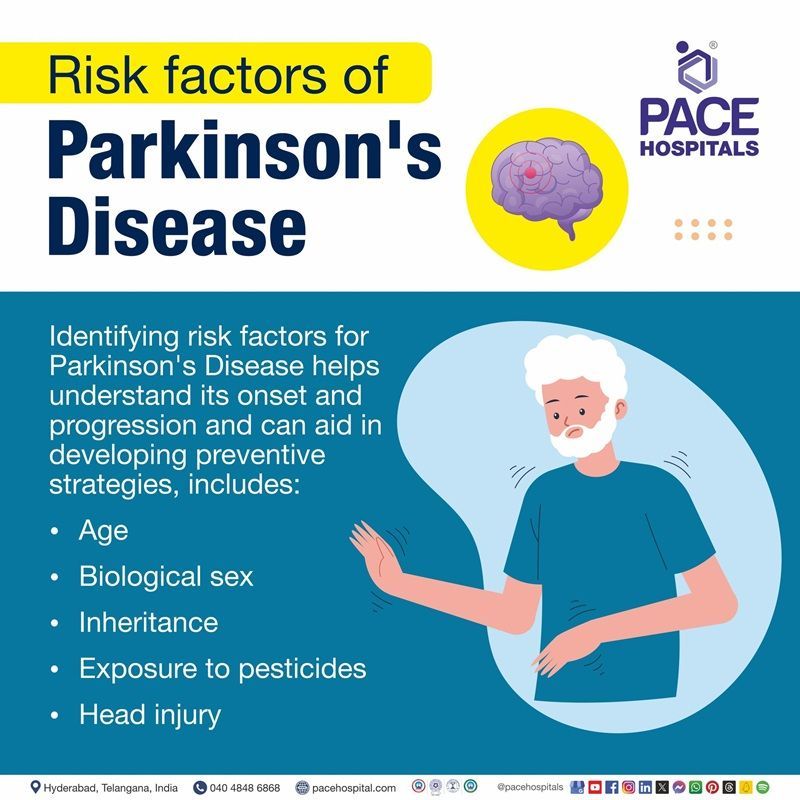
Parkinson’s Disease Risk Factors
Identifying Parkinson’s Disease risk factors helps understand their onset and progression and can aid in developing preventive strategies. Here's an overview of the risk factors associated with Parkinson's disease:
- Age: Parkinson's disease significantly affects the substantia nigra, a brain region where aging leads to a gradual loss of neurons.
- Biological sex: Parkinson's disease affects more men compared to women because of neuroprotective effects of estrogen, which women have at higher levels until menopause. Genetic and hormonal differences, including changes in dopamine function and exposure to environmental toxins also contribute to increased risk.
- Inheritance: Parkinson's disease is inherited through genetic variations in genes such as SNCA, LRRK2, and PINK1, increasing the risk of developing the condition in those with a family history.
- Exposure to pesticides: The use of pesticides has been associated with Parkinson's disease, as these substances can lead to damage to neurons that produce dopamine through neurotoxicity and oxidative stress. Prolonged or intense exposure raises the likelihood of developing Parkinson's disease by the degeneration of neurons.
- Head injury: Repeated head injuries increase Parkinson's disease risk due to degenerative brain changes, which triggers inflammatory reactions and cause brain cell loss. The lasting impact of these injuries increases the risk, including inflammation and tau protein build-up.
Parkinson's Disease Symptoms
Signs and symptoms of Parkinson’s disease typically gets worse and become more challenging to manage. These clinical features of parkinson's disease may vary from person to person in terms of progression and intensity, they are divided into two types, as mentioned below:
Motor symptoms of Parkinson’s disease
- Tremor (Parkinson's disease tremor)
- Rigidity (Stiffness)
- Bradykinesia (Slowness)
- Postural instability
Non-motor symptoms of Parkinson’s disease
- Depression
- Emotional changes
- Difficulty in swallowing and chewing
- Speech changes
- Urinary problems or constipation
- Skin problems
- Sleep problems
- Dementia or other cognitive issues
Motor symptoms: These are associated with the loss of striatal dopaminergic neurons. Four primary symptoms of Parkinson's are:
- Tremor: The shaking typically starts in the hands, sometimes initially affecting the foot or jaw. In Parkinson's disease, the tremor is characterized by a rhythmic back-and-forth motion involving the thumb and forefinger, resembling a "pill-rolling" motion, which is one of the early symptoms of Parkinson's disease. It is most noticeable when the hand is at rest or when the person is stressed, and it disappears during the sleep or with voluntary movements.
- Rigidity: Most individuals with PD experience muscle stiffness, known as rigidity, which causes constant tension and resistance to movement. When another person tries to move the individual's arm, it may only move in short, jerky motions, a condition referred to as "cogwheel" rigidity.
- Bradykinesia: This decreased ability to move spontaneously and automatically can be incredibly annoying when it makes even easy tasks challenging. Things like washing and dressing that were once performed quickly and easily now take much longer. A facial expression frequently becomes less expressive, also called a "masked face."
- Postural instability: It refers to impaired balance, coordination, and changes in posture, which can sometimes lead to increase the risk of falls.
Non-motor symptoms: Non-motor symptoms of Parkinson's disease (PD) are related to neuronal loss in dopaminergic regions, some of the symptoms include:
- Depression: Certain individuals may experience a decrease in motivation and starts relying more on their family members.
- Emotional changes: People with PD might start feeling fearful or insecure, while others may become more easily irritable or unusually depressed.
- Difficulty with swallowing and chewing: Challenges with swallowing and chewing may arise in the advanced stages of the disease. This can lead to food and saliva accumulating in the mouth and throat, potentially causing choking or drooling. Maintaining proper nutrition may become difficult.
- Speech changes: Approximately half of individuals with PD may encounter speech difficulties such as speaking softly in a monotone or experiencing hesitations, slurring, or speaking too quickly.
- Urinary problems or constipation: Issues with the bladder and bowel can occur due to the malfunction of the autonomic nervous system, which regulates smooth muscle activity.
- Skin problems: Some individuals may experience oily skin on the face, especially on the forehead and nose. The scalp might also become oily, leading to dandruff. In other cases, the skin can become excessively dry.
- Sleep problems: Common sleep issues in PD include feeling asleep, restless sleep, nightmares, vivid dreams (one that feels so real that can recall it very clearly when waking up), and daytime drowsiness or sudden sleep episodes. Some medications used to treat PD may also contribute to these sleep disturbances. Many of these problems can be addressed with specific therapies.
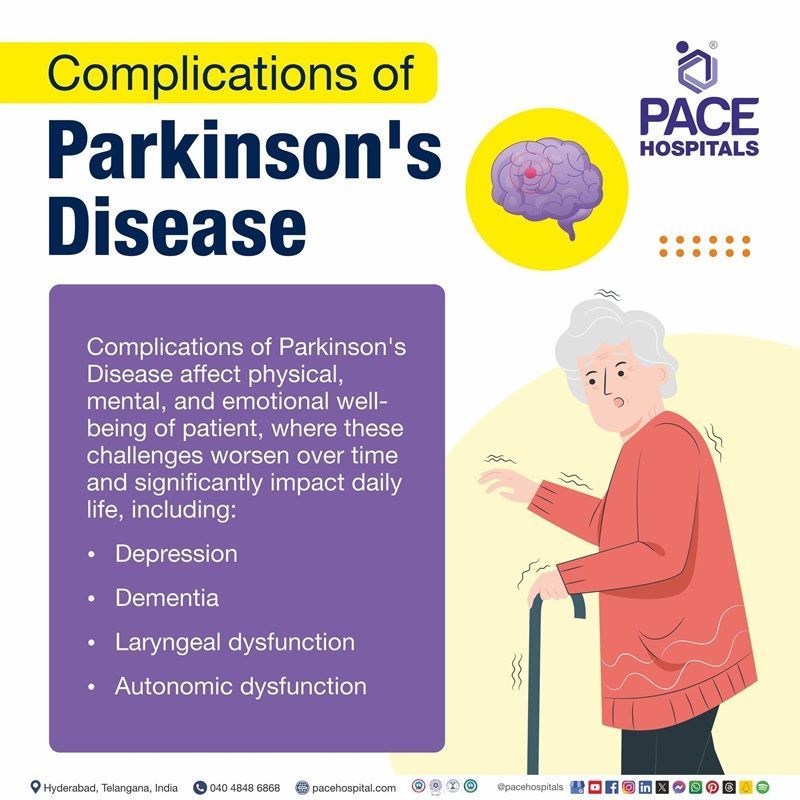
Complications of Parkinson's Disease
Complications of Parkinson's Disease affect physical, mental, and emotional well-being of patient, where these challenges worsen over time and significantly impact daily life, including:
- Depression: Parkinson's disease is related to dopamine depletion, which affects mood regulation. Neurodegeneration in brain regions responsible for emotion can exacerbate depressive symptoms. Additionally, the stress of living with a progressive illness contributes to the development or worsening of depression.
- Dementia: Some individuals with PD may experience memory difficulties and slower thinking. Mental issues can worsen in the later stages of PD, and some individuals may be diagnosed with Parkinson's disease dementia (PDD). Memory, social judgment, language, reasoning, and other mental abilities may be impacted.
- Laryngeal dysfunction: In Parkinson's disease laryngeal dysfunction often referred to as "Parkinsonian dysphonia" or "Parkinsonian dysarthria." These terms describe the voice and speech impairments associated with the disorder, reflecting the impact on vocal cord function and overall speech production .
- Autonomic dysfunction: Parkinson's disease leads to autonomic dysfunction due to the deterioration of dopaminergic neurons, which affects the regulation of the autonomic system. This malfunction impairs the autonomic nervous system's ability to control involuntary functions including blood pressure, heart rate, and digestion. As a result, patients commonly face symptoms such as orthostatic hypotension, gastrointestinal problems, and urinary issues, highlighting the broad influence of Parkinson's on autonomic regulation.
Parkinson’s Disease Diagnosis
There is no specific Parkinson's disease test, such as lab or imaging studies. Diagnosis is difficult, specifically in the early stages of PD, because symptoms are usually mild. It is based on symptoms, medical history, and a thorough physical examination by a general physician. The following are some of the Parkinson's Disease diagnostic tests:
- Physical examination
- Magnetic resonance imaging
- DAT scan
Physical examination: During the evaluation, a general physician may engage the individual in simple physical or mental activities, like walking or moving around, to aid in the diagnostic process. If a GP suspects Parkinson's disease, they will be referred to a specialist. This specialist is typically a neurologist who specializes in conditions impacting the brain and nervous system, a geriatrician or a specialist in problems affecting older adults. The neurologist will probably request to perform several physical exercises so they can assess whether there are any problems with movement.
Magnetic resonance imaging: MRI is advised to diagnose Parkinson's disease (PD). It detects neurodegenerative changes in the brain's nigral structure. Moreover, MRIs can distinguish PD from other Parkinsonian syndromes and track the advancement of the disease.
DAT scan: It is also known as dopamine transporter scan (DAT) is a specialized imaging technique used to evaluate the dopamine system in the brain, particularly in the relation to Parkinsonian disorders. It can be particularly useful in diagnosing Parkinson's disease (PD) and differentiating it from other conditions with similar symptoms.
Parkinson's Disease Treatment
Parkinson's disease has no cure, but treatments manage symptoms and improve quality of life. Early stages may not require treatment due to mild symptoms. Parkinson’s disease treatment options include:
- Drugs For Parkinson's Disease
- Dopamine precursors
- Dopamine agonists
- COMT (catechol-O-methyltransferase) inhibitors
- MAO-B (monoamine oxidase B) inhibitors
- Antiviral agents
- Anticholinergic medications
- Surgical Management for Parkinson's Disease
- DBS surgery
- Lesion surgery
- Alternative Treatment for Parkinson's Disease
- Physiotherapy
- Speech and language therapy
Drugs For Parkinson's Disease
Drugs used in Parkinson’s disease aim to control symptoms by boosting dopamine levels or mimicking their actions in the brain. Key medication types include:
- Dopamine precursors: These are the primary components that substitute dopamine. They work by replacing dopamine, inhibiting dopamine breakdown, and sensitizing dopamine receptors to stimulate dopamine release.
- Dopamine agonists: These are chemical compounds that bind to dopamine receptors in the brain and activate cellular signalling pathways that mimic dopamine's effects
- COMT (catechol-O-methyltransferase) inhibitors: A catechol-O-methyltransferase (COMT) inhibitor is a medication that inhibits the action of the enzyme catechol-O-methyltransferase which breaks down different catecholamine neurotransmitters, such as dopamine and epinephrine.
- MAO-B (monoamine oxidase B) inhibitors: These are medications that treat Parkinson's disease (PD) by blocking the MAO-B enzyme, which breaks the dopamine in the brain.
- Antiviral agent: The drugs with mild antiparkinsonian activity is used for abnormal movement conditions (dyskinesia)
- Anticholinergic medications: These medications are used to lessen tremors, but their use is restricted due to the side effects
Surgical Management of Parkinson's Disease
Surgery might be recommended for Parkinson's disease in certain cases. It relieves symptoms but doesn't cure or prevent the condition. It can reduce tremors, rigidity, and medication needs in some patients.
There are two main types of surgeries for Parkinson's disease:
- DBS surgery
- Lesion surgery
- Deep brain stimulation: DBS surgery for Parkinson’s disease involves surgically placing a small electrode in the deep areas of the brain to regulate movement. This electrode is connected to a small battery in the chest wall via wires placed under the skin. Once activated, the stimulator disrupts the flow of information in the brain, causing Parkinson's. It can also help decrease symptoms.
- Lesion surgery (scarring of tissue): In this lesioning surgery for Parkinson’s disease small lesions or scars are created in the deep areas of the brain responsible for regulating movement. The procedure may be conducted while the patient is awake to ensure the exact placement of the lesion, intended to prevent the tremor caused by that specific brain area.
Alternative Treatment for Parkinson's Disease
Several therapies can make living with Parkinson's disease easier and help to deal with symptoms on a day-to-day basis.
- Physiotherapy: A physiotherapist can recommend physiotherapy for Parkinson's disease to relieve muscle stiffness and joint pain through movement and exercise.
- Speech and language therapy: People with Parkinson's disease have difficulty in swallowing (dysphagia) and problems with their speech. This can be achieved by teaching speaking and swallowing exercises.
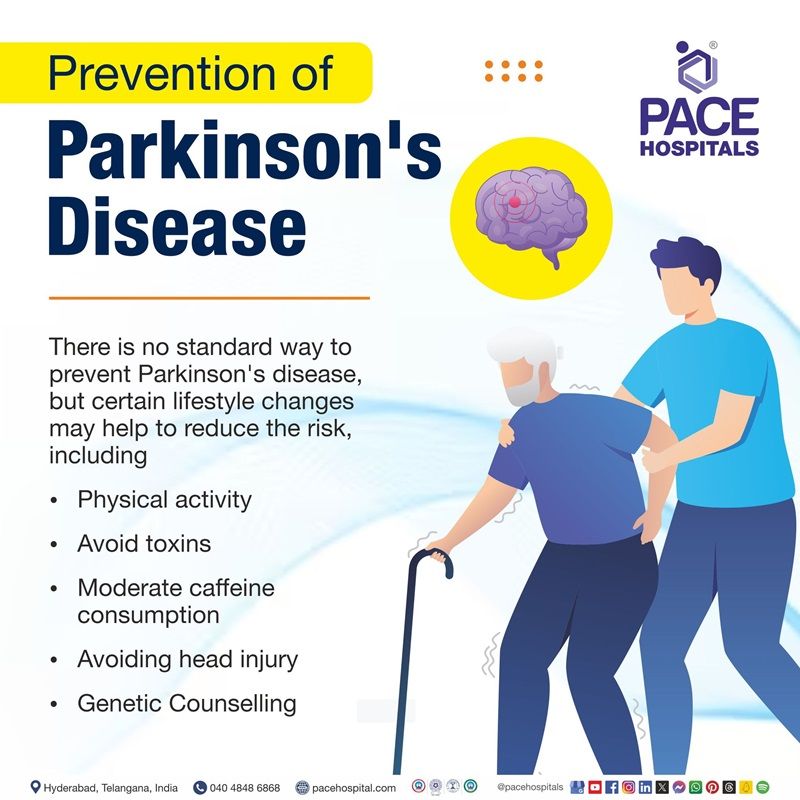
Parkinson’s Disease Prevention
Parkinson’s Disease prevention does not have a standard approach, but certain lifestyle changes may help to reduce the risk, including:
- Physical activity: Regular physical exercise promotes overall health and lowers the risk of Parkinson's disease. Walking, swimming, and strength training are beneficial exercises for Parkinson’s diseases as these improves blood flow, supports brain health, and helps maintain motor function.
- Avoid toxins: Avoiding contact with environmental toxins like pesticides and heavy metals is essential to prevent PD .
- Moderate Caffeine Consumption: Some research suggested that reduced risk of Parkinson’s disease is linked to moderate caffeine intake. Caffeine's potential neuroprotective effects are still under research so that moderate intake may be beneficial, but it should be balanced with other health considerations.
- Avoiding head injury: Protecting the head from trauma, such as wearing helmets during biking or contact sports, to reduce the risk of trauma.
- Genetic Counselling: If Parkinson's disease runs in the family, consulting with a genetic counsellor provides insights into risk and potential preventive strategies.
Difference Between Alzheimer’s and Parkinson’s Disease
Alzheimer's disease vs Parkinson's disease
Understanding these following differences is essential for diagnosis and treatment.
| Elements | Alzheimer’s Disease | Parkinson’s Disease |
|---|---|---|
| Affected Region/ Cause | Extensive neuronal loss that leads to brain tissue atrophy. Along with Neurofibrillary tangles in the neocortex and hippocampus, extracellular amyloid- Aβ) deposits, senile plaques, and amyloid plaques | Neuron degeneration and loss of dopamine in the substantia nigra pars compacta in the midbrain. |
| Symptoms | Progressive memory decline. It affects cognitive functions such as communication and movement | The clinical manifestations of PD are bradykinesia, resting tremor, and postural instability |
| Age of Onset | Late-onset variety symptoms first appear in the mid-60’s, early-onset AD begin between a person’s 30s and mid-60s | The average age of Parkinson’s disease is 56. , around 4 per cent of Parkinson’s patients are diagnosed before the age of 50, The youngest recorded case of Parkinson’s was a 12-year-old patient |
| Prognosis | The prognosis includes Irreversible loss of memory leading to Dementia | Prognosis Dementia also known as irreversible loss of memory. |
Frequently Asked Questions (FAQs) on Parkinson's Disease
Is Parkinson's Disease Genetic?
Parkinson's disease can be genetic, with specific gene mutations such as SNCA, PRKN, and PINK1. While most cases are not inherited, having a family history can increase the risk, especially in familial Parkinson's.
What causes Parkinson's Disease?
The cause of Parkinson's disease is unknown, but experts believe it is a combination of genetic and environmental factors that leads to the death of dopamine-producing nerve cells.
Can Parkinson’s disease be cured?
Currently, Parkinson's disease has no cure, but treatments are available to reduce the symptoms of PD and maintain the individual's quality of life.
Is Parkinson’s disease fatal?
Parkinson's disease is not fatal, but the condition can weaken the body and increase susceptibility to severe infections. However, advancements in treatment have led to a regular or average life probability for most individuals with Parkinson's disease.
What is the role of medication in managing Parkinson’s disease?
Medications help increase dopamine levels or mimic dopamine effects in the brain, improving motor symptoms and overall function. Common medications include levodopa, dopamine agonists, and MAO-B inhibitors.
What Is Parkinson’s Disease?
Parkinson's disease or PD is a neurological condition that affects the brain, leading to difficulties with movement, mental well-being, sleep, pain, and other bodily functions.
What is the difference between Parkinson’s disease and Parkinsonism?
Parkinson’s disease is a specific type of Parkinsonism with idiopathic origins, while Parkinsonism refers to a broader category of movement disorders that resemble Parkinson’s disease but may have different causes.
How is Parkinson’s disease diagnosed?
Diagnosis of Parkinson’s disease is based on clinical symptoms and medical history. Neurologists may utilize imaging tests and neurological exams to rule out other conditions.
Is surgery a viable option for Parkinson’s disease?
Deep brain stimulation (DBS) surgery may be considered for individuals with advanced Parkinson’s disease who do not respond well to medications. DBS can help manage motor symptoms by targeting specific brain regions.
Share on
Request an appointment
Fill in the appointment form or call us instantly to book a confirmed appointment with our super specialist at 04048486868

